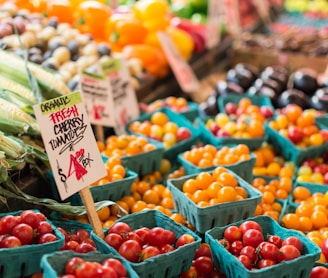How to Choose the Best Citrus Fruits
Learn how to select the juiciest and most flavorful citrus fruits for your meals and snacks. From oranges to lemons, we'll guide you through the process of picking the perfect citrus fruits every time.
Choosing the best fruits can sometimes be a bit of an art. Whether you're shopping at a grocery store, farmer's market, or picking from your own garden, selecting ripe, flavorful fruits enhances your culinary experience and ensures you're getting the most nutritional benefits. Here's a comprehensive guide to help you pick the freshest and tastiest fruits every time.
1. Know the Season
The first step in selecting the best fruits is to know what's in season. Seasonal fruits are typically fresher, more flavorful, and may be more affordable. Additionally, fruits in season are likely to have a higher nutrient content. Research what fruits are in season in your region and prioritize those when shopping.
2. Look for Vibrant Colors
When choosing fruits, opt for those with vibrant colors. For example, ripe strawberries are bright red, oranges should have a deep orange hue, and ripe bananas are yellow with brown spots. Dull or muted colors can indicate that the fruit is not at its peak ripeness.
3. Check for Firmness
The firmness of a fruit can indicate its ripeness. Some fruits, like apples and pears, should feel firm but not rock hard. Others, like peaches and avocados, should yield slightly to gentle pressure when ripe. Avoid fruits that are overly soft, as they may be overripe or starting to spoil.
4. Smell the Aroma
A fruity aroma is often a good sign that the fruit is ripe and flavorful. For example, a ripe cantaloupe should have a sweet, fragrant smell. Citrus fruits like oranges and lemons should be aromatic when you give them a gentle squeeze.
5. Check the Stem
For fruits like berries and cherries, inspect the stem area. Fresh berries should have green, fresh-looking stems. Avoid berries with moldy or mushy stems. For cherries, look for stems that are bright green and attached firmly to the fruit.
6. Examine the Skin
Inspect the skin of the fruit for any blemishes, bruises, or signs of mold. Fruits with smooth, intact skins are less likely to have been damaged during handling or transport. Be cautious of fruits with soft spots, as they may be starting to spoil.
7. Consider Weight
Heavier fruits often indicate juiciness and ripeness. For example, a ripe watermelon should feel heavy for its size. When choosing citrus fruits like oranges or grapefruits, go for the ones that feel heavier as they are likely to be juicier.
8. Know Your Varieties
Different varieties of the same fruit can vary in flavor, sweetness, and texture. Experiment with different varieties to find your favorites. For example, there are numerous types of apples, each with its own unique flavor profile—from sweet Honeycrisp to tart Granny Smith.
9. Ask for Advice
If you're unsure about selecting a particular fruit, don't hesitate to ask for advice. Farmers, grocers, and market vendors are often knowledgeable about the produce they sell and can offer guidance on choosing the best fruits.
Final Thoughts
Choosing the best fruits involves a combination of sensory cues, knowledge of seasonal availability, and a little bit of practice. By following these tips and trusting your instincts, you'll be able to select fruits that are not only delicious but also packed with essential nutrients. Enjoy the bounty of nature's sweet offerings and savor the flavors of perfectly ripe fruits in your meals and snacks!



